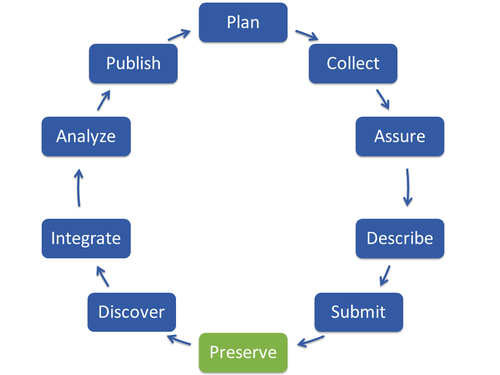Preserve
What is it?
Preserving is more than a backup. It is a set of actions, which ensure long-term retention of the integrity of data, by maintaining its (a) accessibility, (b) authenticity and (c) longevity. Digital objects are fragile, being susceptible to “data rot” which might influence their accessibility and authenticity. Preservation aims to ensure that datasets are in the best shape to be stored, discovered, accessed and re-used. It implies recurring activities.
- Accessibility: Data can be retrieved, displayed and used.
- Authenticity: Data have not been manipulated, substituted or faked.
- Longevity: Data are re-usable for long-term, independently of software and hardware decay.
There are different digital preservation methods, such as migration, emulation, digital archaeology, and technology preservation.

How to do it?
- Be aware of the requirements of your data center/archive to preserve and store data.
- If the data set is not already in an open access file format, then it should be migrated (transformed). The original data bit stream should be kept before migration to other formats is done.
- Preservation metadata should be added and all migration procedures documented. A detailed description of the preservation actions should be included.
- Quality procedures, such as checking the original and the migrated bit stream or checking the sums should be performed to assure the authenticity of the data and to prevent information loss during the migration process or after a certain period of time.
- Backup is just one component of preservation.
- Refresh should be done periodically to prevent data rot.
Who does it?
Preservation is usually carried out by archives, data centers or data managers after data have been submitted by the data producer. However, data producers can facilitate the process by performing good data management practices in the preceding steps of the data life cycle.
Key Elements
- Migrate data to the best format (open, non-proprietary) and suitable medium.
- Document preservation actions (workflow).
- Create preservation metadata.
- Backup and store data.
GFBio Services
Data Archiving
- GFBio offers a single point of contact to experts from all associated data centers and an integrated search of the data available at the data centers (see Fact Sheet ‘Discover’).
Useful Links
http://www.dcc.ac.uk/resources/how-guides/cite-datasets (DCC How-To-Guide)
http://databib.org (useful data repository registry)
http://www.re3data.org (useful data repository registry)
http://en.wikipedia.org/wiki/Data_degradation (Information about data degradation)
Recommended citation:
German Federation for Biological Data (2021). GFBio Training Materials: Data Life Cycle Fact-Sheet: Data Life Cycle: Preserve. Retrieved 16 Dec 2021 from https://www.gfbio.org/training/materials/data-lifecycle/preserve.